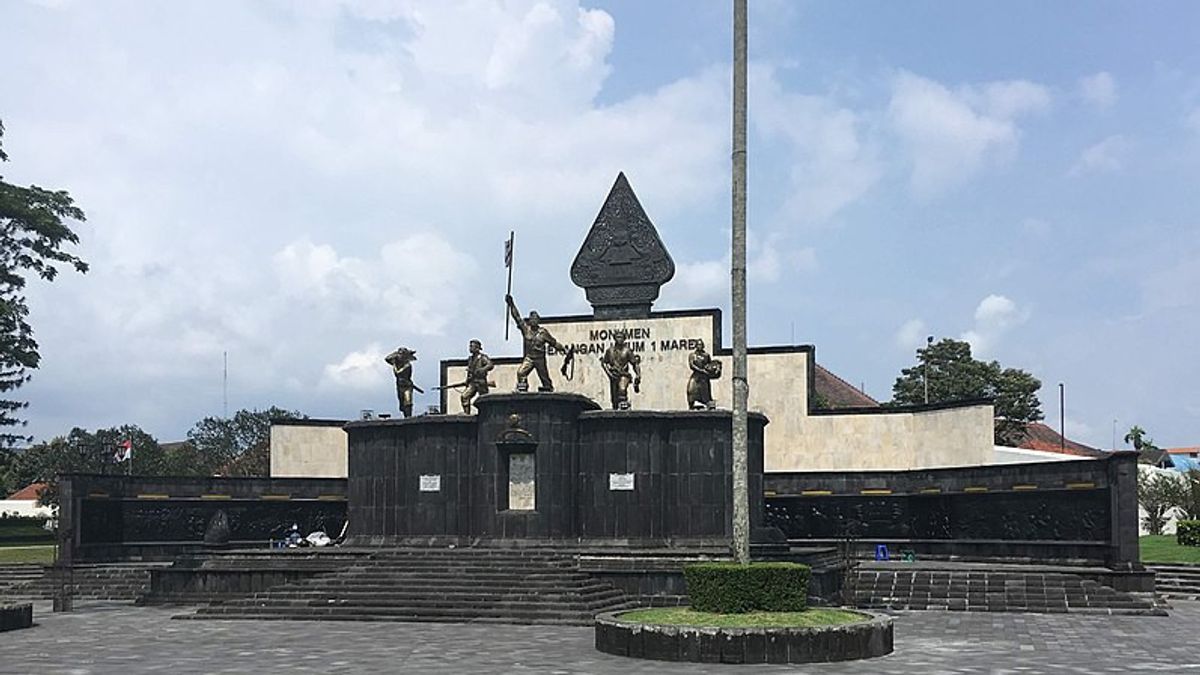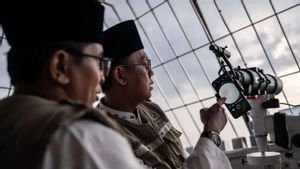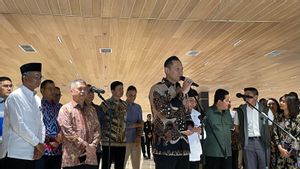JAKARTA - Presidential Decree (Keppres) Number 2 of 2022 concerning the Day of Enforcement of State Sovereignty has been widely discussed. The absence of the name of former President Suharto is the source of the problem. Suharto, who at that time held the rank of Lieutenant Colonel, was not named as the intellectual actor of the March 1st General Offensive, 1949. Many other figures had the same fate. Issues developed. The government is considered to want to reduce Suharto's role in the nation's history. Is it true that those in power intend to eliminate Suharto from the historical map?
The decision of President Joko Widodo (Jokowi) has often provoked controversy. The issuance of Presidential Decree No. 2 of 2022 concerning the State Sovereignty Enforcement Day, for example. Jokowi signed the Presidential Decree on February 24, 2022. The goal is noble, to review the events of the March 1 General Attack.
Unfortunate can't be denied. Jokowi's intention was to be arrested on the contrary by the entire audience. He is considered to want to reduce the role of the second former President of Indonesia who served 32 years. Suharto's alias is implicitly described as not having an important role. Moreover, meritorious.
This assumption is strengthened when one looks at the contents of the Presidential Decree on the preamble to letter C. It is emphasized that the General Offensive of 1 March 1949 was initiated by Sri Sultan Hamengkubuwono IX. He then ordered the Commander in Chief General Sudirman. Everything with permission and approved by President Soekarno and Vice President Mohammad Hatta.
Another point that is considered to contain historical confusion is that the attack received dominant support from the military apparatus: the Indonesian National Armed Forces (TNI), the Indonesian National Police (Polri), and the army of fighters. While Suharto's name was not mentioned at all. So did the other fighters.

"That the events of the March 1, 1949 General Offensive were initiated by Sri Sultan Hamengkubuwono IX and ordered by the Commander in Chief General Sudirman and were approved and moved by President Soekarno and Vice President Mohammad Hatta and supported by the TNI, Polri, the people's struggle armies, and all components. other Indonesians.”
"It is an important part in the history of the struggle of the Indonesian nation, which is able to re-establish the existence and sovereignty of the Indonesian state in the international world and has succeeded in reuniting the awareness and spirit of the unity and integrity of the Indonesian nation," stated in the preamble point C of Presidential Decree No. 2 of 2022.
The polemic then provoked the Coordinating Minister for Political, Legal and Security Affairs Mahfud MD to speak up. Mahfud revealed that the Presidential Decree was not a history book. The Presidential Decree will not be able to accommodate all the figures involved in the March 1 General Offensive. Therefore, only the important parts are listed. If you want to discuss at length about the figures, then the Presidential Decree is not the right medium.
"The Presidential Decree is not a history book but the determination of a crucial point in history. The presidential decree does not omit the names of Suharto and others in the March 1, 1949 General Offensive. The name and role of Suharto is mentioned in the Presidential Decree Academic Papers whose sources are comprehensive," Mahfud MD wrote in a tweet on Twitter, Thursday, March 3.
The issuance of the Presidential Decree made some Indonesians angry. A politician from the Gerindra Party, Fadli Zon, is one of them. The point of consideration for the letter C is allegedly an attempt to distort history. He also called for the Presidential Decree to be corrected immediately. The Presidential Decree contains a lot of incorrect historical data. The role that was reduced was not only Suharto, but also the role of the Emergency Government of the Republic of Indonesia (PDRI), led by Syafruddin Prawiranegara.
"I have read Presidential Decree No. 2/2022 on the Day of State Sovereignty Enforcement, it should be revised immediately. Historical data is a lot wrong. Apart from eliminating the role of Lieutenant Colonel Suharto as field commander, it also eliminates the role of the Emergency Government of the Republic of Indonesia (PDRI). Fatal. @jokowi, @mohmahfudmd," he said via Twitter @fadlizon, Friday, March 4.
Presidential Decree: The Second ProductIt is possible that the Presidential Decree issued has sparked controversy. But what needs to be remembered is that the Presidential Decree is closely related to political content. Young historian alumnus of Gadjah Mada University Yogyakarta and Universiteit Leiden, the Netherlands, Ody Dwicahyo said that it was the government's duty to package a part of history into a final product that made the goal of nation-building efforts.
The products include national celebrations, national heroes, or texts to support the awarding of service stars to someone. He also gave the term Presidential Decree as the product of a historiography (historical writing). Or in Ody's language it is called: second product.
Therefore, the function of the second product is none other than extracting historiography written as academic texts. As a result, there are elements that definitely cannot be transported. Including the case of the Presidential Decree which is considered to reduce Suharto's war from the March 1 General Offensive.
To the best of his knowledge, Suharto's role was written in academic texts being prepared by the Department of History, Gadjah Mada University. But the audience also needs to know that history is something that is very subjective. The chosen element or not, becomes the monopoly of the second product maker.

This chaos is proof that many parties are still using the old glasses to see historiography. They see that history tends to have heroes. In fact, an incident often involves many parties. This means that there is a collective effort to build a dream: Indonesian Independence.
“In my opinion, this commotion occurs because people do not understand that a historiography alone has limits, let alone a second product that is composed of it. I regret that, as the name suggests, this commotion has only reinforced the views I have criticized: that history must have superheroes, that someone has to play the biggest role and the like."
“Besides that, nothing but the crystallization of political thought that we have had for a long time has surfaced again. Instead of provoking the public to read more, this commotion actually drags them to prioritize their arguments, even if they are without content,” explained Ody to VOI, Monday, March 8.
Collective EffortIn line with Ody, historian Sam Ardi prefers the narrative of the March 1 General Offensive as a collective effort by the fighters to defend Indonesia's independence. Because, in principle, an attack on the Netherlands could not have happened if it was only carried out by one person. It certainly involves many parties.
Not only does the entire role of the military become a monopoly, but the civilians also participate in the war. For example, the March 1 General Offensive was tactically and operationally executed by the army. As for other needs, broadcasting news, providing safe routes, supplying food, is the biggest role of civil society.

After all, there was no way a field commander would suddenly play the role of a news messenger. Moreover, they also acted as emissaries to pressure the Dutch at the United Nations and provide space for negotiations.
“For example, the order to carry out the General Offensive from Colonel Bambang Soegeng as Commander of Division III/Governor of Military III contained in the Secret Instructions from February 25 to March 1. Lieutenant Colonel position. Suharto is in the Wehrkreise III area, one of which includes Yogyakarta. Based on this, the role of Lt. Col. Suharto as a field executor is very clear.”
"Also the Mayor of Yogyakarta, Sudarisman Purwokusumo, together with First Lieutenant Marsudi, who provided a safe route for the fighters to travel while in Yogyakarta. Major Soekasno and his troops were able to block a Dutch aid troop named Dog NICA, from Magelang led by Colonel Adrianus van Zanten. It was estimated that the Dutch troops would arrive in Yogya within two hours but could be withheld and delayed by four hours. Also parties such as Code Officers (code officers), couriers, village heads, and sub-district heads," concluded Sam Ardi when contacted by VOI, Monday, March 8.
So it is clear that Suharto had a role in the General Offensive of March 1, 1949. However, his name does not need to be mentioned in a political product called Presidential Decree Number 2 of 2022 because based on historical facts Suharto was not the highest command holder at that time.
The English, Chinese, Japanese, Arabic, and French versions are automatically generated by the AI. So there may still be inaccuracies in translating, please always see Indonesian as our main language. (system supported by DigitalSiber.id)









